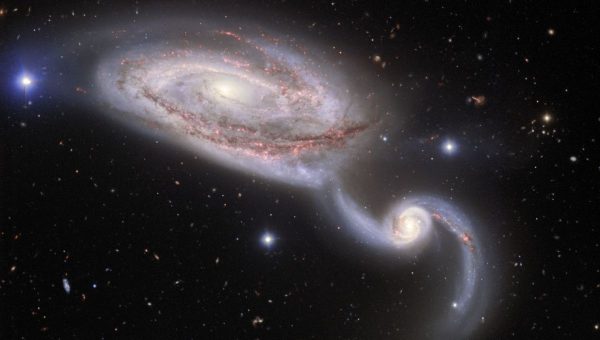When galaxies collide, you get… a heron? – SYFY WIRE

The galaxies NGC 5394 and 5395, undergoing a very close pass that’s affecting both of them. Credit: NSF’s National Optical-Infrared Astronomy Research Laboratory/Gemini Observatory/AURA
Contributed by
Dec 20, 2019
Boy oh boy, do I love me a good galaxy collision.
are collections of billions (or, for big ones, hundreds of billions) of stars, sometimes with lots of gas and dust, surrounded by a halo of invisible . On the whole they’re pretty big, tens or hundreds of thousands of light years across.
That size becomes interesting when you consider that many galaxies come in groups or clusters, where they may be dozens or hundreds or thousands of galaxies. They all move around, and are separated by a few million light years. That’s a lot, sure, but the size of any individual galaxy is a pretty decent fraction of that. That means .
On top of that galaxies have a lot of mass, which means a lot of gravity. They don’t have to physically collide for them to affect each other; a near pass will do. The closer the pass the greater the affect, especially when you have a smallish galaxy passing a larger one.
Then, things get interesting.
So , two galaxies that are passing in the night:
The galaxies NGC 5394 and 5395, undergoing a very close pass that’s affecting both of them. Credit:
Wow. Did I mention I love me some galactic collisions? You can see why. They’re gorgeous!
The pair is about 160 million light years from Earth, close enough on a cosmic scale for us to get a pretty good look, especially when we’re looking with the mammoth Gemini North 8-meter telescope (to wit: The primary mirror is 8 meters across, the size of a very large living room or the width of a tennis court). Incredibly, this image, which used multiple observations in different filters to create a color composite, had a total exposure time of just 42 minutes. Holy cow.
The little one, NGC 5394, is passing the bigger one, NGC 5395. The gravity of the encounter does interesting things to both galaxies. For example, a star in the outer disk of the little one feels a pull toward the galaxy’s center, but as it passes the other galaxy the gravity of it pulls on the star as well. This draws out a long streamer from the little galaxy, called a tidal tail. The smaller galaxy was probably already a spiral, but the arms got pulled out like taffy and exaggerated during the encounter.
The bigger galaxy is affected, too; you can see distortions in the arms. Look at the bottom right of the galaxy: The dark dust lanes and pink gas clouds don’t align with blueish arms (where massive, hot, blue stars form). I have a suspicion that dust lane can be traced clockwise past that bright star to the left and back all the way around the galaxy to a different spiral arm, which is why it appears above the blue arm. I also can see faint blue trails on both the left and right of the big galaxy, too. What a mess!
A wide-angle view of the colliding galaxies NGC 5394 and 5395. Credit:
Both galaxies are undergoing a burst of star formation (the pink gas clouds are where stars are busily being born, lighting up the gas around them). That’s common in collisions. Interestingly, (and mentioned in the Gemini press release) says that there’s a ring structure in the big galaxy, difficult to see here but clearer in other images, that indicates there was a previous encounter between these two! Rings can occur when there’s a direct collision, and a small galaxy passes through the disk of the bigger one. If that’s the case, this may be the second time these two have interacted. In turn, that implies the smaller one is gravitationally bound to the bigger one, and that means its fate is sealed: Merger. The two will collide again, coalescing into one, bigger galaxy.
I mentioned earlier that galaxies are big compared to the distances between them. That’s not the case for stars. A big star might be a few million kilometers across, but they tend to be many trillions of kilometers apart. That makes a physical collision between stars unlikely, at least in the outer parts of the galaxy. In the inner part, near the center, distances are much smaller. Also, so many stars drop down into the center that a collision becomes possible. Still, it’s rare compared to the sheer number of stars in a galaxy, very much the exception and not the rule.
Gas clouds, on the other hand, can be many light years across, so collisions between them are not only common in collisions but inevitable. That’s why so many galaxy mergers are also undergoing a burst of star formation: The clouds collide, collapse, and churn out lots of stars.
One more thing. In the press release, as well as in a few other places, I found the nickname for this pair: The Heron Galaxy. At first that struck me as weird; they don’t look like a heron to me. Then I realized I needed to rotate the image:
The Heron Galaxy (NGC 5394/5395, right) and the Heron (left). Credit:
Oh. That’s better! The other shot is a Great Blue Heron I spotted here in Colorado by a pond. The resemblance is actually pretty good.
But not for long. In a few million years this pair will look very different. The size difference is enough that I think the bigger galaxy will retain its overall disk structure, if not the spiral. I guess astronomers in that far future will have a better sense of that.
Incidentally, this will happen to our own galaxy as well, when we collide with Andromeda. But breathe easy: You have about 4.6 billion years before that happens. Plenty of time to prepare. And in the meantime we can look to collisions like the Heron Galaxy to learn more about our own distant fate.








